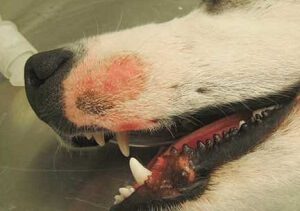Your dog might be suffering from mange if you notice he is scratching all the time and some patches of fur are either missing or thinning. This is actually a skin condition that occurs due to mites of microscopic sizes infesting the skin. THe good news is that this is nothing to worry about. Mange is not only treatable but also pretty much preventable in dogs.
The actual type of mite: Demodectic or sarcoptic?
There are two types of mites causing mange, which means that your dog can actually suffer from two types of mange. Most of the time, this medical problem will be caused by Sarcoptes Scabiei, also known as the sarcoptic mite, which is a mite species that is very closely related to the Notoedres. So, from the name of the mite, this type of mange will be known as scabies. These types of parasites can be caught by your dog either from its bedding, or from other animals, and they can also be passed to humans.
On the other hand, demodectic mites, are always present in your dog’s fur, to the root of the hairs, and are known as follicles. The mother will pass them on to her puppies within the first days of their life. Demodectic mites are usually kept in check by the animal’s own immune system. But mange is still possible and will usually happen when the mite population gets out of control. As opposed to the first type of mange, the demodectic one isn’t a contagious disease.
Symptoms and Causes of Demodectic Mange
Demodex or Demodectic mites are part of the skin’s oil glands and hair follicles of the dog from a very early age. They won’t usually cause problems, at least for most dogs. They will only become an issue when the immune system of the dog weakens. Among the dogs that are most likely to develop demodectic mange are those suffering from underlying medical conditions such as cancer or diabetes, as well as older dogs and puppies.
Demodectic mange can be either generalized or localized. Hair follicles will become irritated whenever there is an overgrowth of demodectic mites. While in its earlier stages, the Demodex mange will feature less visible symptoms than the sarcoptic mange and it won’t be as itchy either. It will be noticed only due to some small areas where the hair is falling, most of the time. This is what experts call localized Demodex.
When it affects puppies, this illness, also known as red mange, will cause scaly bald spots around the front legs and on the head and lips of the pup. As the immune system of a puppy will start to kick in, most of the time the problem will resolve on its own.
There are also situations in which demodectic mange will become widespread on the pet’s body. This is what experts call a generalized type of Demodex. This will usually be accompanied by symptoms like:
- Bacterial infections with a smelly odor
- Scabbing and/or crusting of the skin
- Itchiness
- Skin discoloration
- Oily, bumpy skin
- More hairless patches
Symptoms and Causes of the Sarcoptic Mange
Although Sarcoptic mites are so small that it’s impossible for you to notice them with the naked eye, you will surely notice the intense scratching of your dog. These very small mites will not only feed and live on the pet’s skin, but the females will also burrow underneath the top part of the skin to lay their eggs.
Keep in mind that when it comes to mange caused by sarcoptic mites, this is a highly contagious disease. Also, according to experts, it is also a very common disease among wildlife. This means that if your dog gets in contact with foxes or other wild animals, then it will be very likely to develop contagious mange.
You might also like my articles on eye infections, paw infections, and atopic dermatitis in dogs.
Sarcoptic mites can also get on your dog from other dogs, not just from wild animals. Shelters or boarding facilities are the perfect places for these types of mites to move from one dog to another, especially if the dogs play or live together. Infected blankets or bedding can also infect your dog with mange. Keep in mind that symptoms will only be visible after about 10 days to 8 weeks after it has been exposed to the mites.
Most of the time, within its initial stages, sarcoptic mange will be noticed as an intense itch around the elbows or the ear flaps of the dog. These mites will also enjoy living on the pet’s legs, armpits, and belly as well.
At first, the dog that suffers from sarcoptic mange will scratch all the time, which will cause his skin to get irritated and red. As the illness progresses, it will lead to thickening or crusting of the skin, open scabs or sores, and even hair loss. As the open sores become infected, they will also get smellier. When left untreated, this disease is known to cause enlarged lymph nodes, loss of healthy muscle mass, or even death, in some extreme cases.
Although this is something you will usually see in dogs, humans can also contract sarcoptic mites and the main symptom will be very itchy rashes.
How to Treat Mange in Dogs
Although people often go for the over-the-counter products or home remedy route to bring some relief for their dogs’ itching, this will only be a temporary solution featuring very poor results in the long run. To get rid of the mange, you will also have to get rid of the mites that cause it. First off, get an official diagnosis with the help of a local vet, to find out whether mange is really to blame and what type of mange is your dog dealing with. Your vet will also give you recommendations on the best treatment course to fix this issue.
 The symptoms of mange in dogs are pretty much similar to some other types of skin conditions. For a proper diagnosis, your vet will have to get a hair sample or a skin scaping and analyze it under the microscope. Although a scraping of the skin will surely irritate it even more, at least momentarily, it is a thing that has to be done for proper diagnosis. The microscope will reveal demodectic mites pretty clearly. Sarcoptic mites are a whole different story because they will be more difficult to spot, especially because of their ability to burrow under the skin of the pet. To rule out any other issues or conditions, your vet could also recommend some other tests of the skin or blood.
The symptoms of mange in dogs are pretty much similar to some other types of skin conditions. For a proper diagnosis, your vet will have to get a hair sample or a skin scaping and analyze it under the microscope. Although a scraping of the skin will surely irritate it even more, at least momentarily, it is a thing that has to be done for proper diagnosis. The microscope will reveal demodectic mites pretty clearly. Sarcoptic mites are a whole different story because they will be more difficult to spot, especially because of their ability to burrow under the skin of the pet. To rule out any other issues or conditions, your vet could also recommend some other tests of the skin or blood.
The great thing is that mange has become easily treatable, now more than ever. If past dogs had to go through daily treatments or dips, nowadays, with the help of isoxazoline medications we can treat our pets with ease. These medications will work on mites of both types, but also on ticks or fleas.
It will only take a few days of treatment with oral medications for the pet to feel considerably better. Your vet might also consider prescribing medications to relieve some of the inflammation, discomfort, and of course, itching of the dog while the mites are eliminated. Any secondary skin infections will usually be cleared up with the help of antibiotics.
Is Mange Contagious to Other Pets or Humans?
When talking about the sarcoptic mites and mange caused by them, unfortunately, humans as well as other pets around the home can also get contaminated. There are some precautions that will have to be taken to keep the infected pet from spreading the disease to other pets or humans around the house, since these mites will have no problem passing on to anything alive, basically.
It won’t be enough to just isolate the infected pet from any other animals until it is free of mites. You will also have to clean and disinfect everything your pet has touched, including furniture, bedding, mattresses, carpets, and blankets. You can get the necessary information on how to remove sarcoptic mites from your home and make sure they don’t get back, from your vet.
Can You Prevent Mange in Dogs?
You can also make use of isoxazoline medications to prevent mange, not only to treat it.




